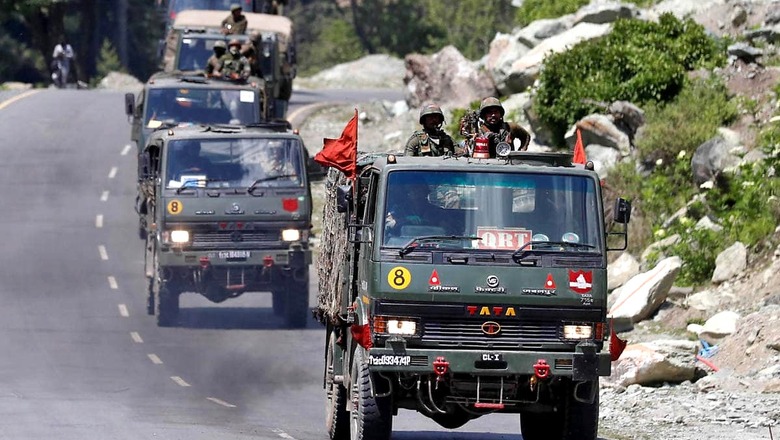
views
Close on the heels of the ninth round of military commander level talks between India and China, reports emerged of a clash between the People’s Liberation Army (PLA) and Indian Army personnel in the Naku La region of Sikkim. The Chinese contingent allegedly attempted to break through the LAC and enter the Indian side but was successfully stopped by the Indian Army team on vigil. As per initial reports, the thrashing given to Chinese PLA personnel by the Indian security forces was resounding enough to leave around 20 of them injured. The fact that the Chinese were at the receiving end of the trouble was perhaps also vindicated by the vociferous attempt by the Chinese government’s mouthpiece Global Times trying really hard to term the incident as ‘fake’, something which the Chinese Communist mouthpieces only do when China is at the receiving end.
Deciphering Beijing’s hidden intentions
Even though on January 24, the ninth round of military commanders’ meeting concluded in the evening on a positive note, and the Sikkim incident was downplayed by India as well, in hindsight one is left to wonder why would China attempt something like this in Sikkim and whether it was a mere act of impulse at the local military leadership level or if there is something more sinister in planning. For a country, which has for long, profoundly believed in Deng Xiaoping’s philosophy of ‘hide your strength, bide your time’, and one which proficiently analyses through every plan before putting them to execution, it is highly unlikely that the Sikkim incident was an act of impulse. So then was China just testing waters before executing another major operation?
The loss of face after Galwan
Post the Galwan incident wherein the PLA soldiers suffered severe casualties during a brawl with Indian Army personnel, there was a brief lull followed by the Special Forces operation by India in the last week of August during which we regained domination in 26 key heights along the Pangong Tso—Chushul region, thereby staring down at all the Chinese PLA formations and putting them at a disadvantageous point altitude wise. This operation by the Indian Army Special Forces and the Special Frontier Forces (SFF) was preceded by razor-sharp precision with which India fortified the entire stretch of the LAC through SSB, ITBP and the Indian Army.
Further, India’s mirror deployment of military personnel and hardware along Eastern Ladakh to match Chinese deployment, stationing of Indian Navy’s frontline ships along the Indian Ocean region, day-night patrolling by Sukhoi-30 MKIs, MiG-29s and Apache helicopters in Eastern Ladakh, precision logistical operations through strategic airlifters such as C-17s, C-130s, IL-76, AN-32s, Chinooks and Mi-17s took away the element of surprise, if at all China had any initially. Induction of Rafales equipped with cold-start capabilities and armed with scalp cruise missiles made China put at halt all its plans for further escalation. All this while, India’s security agencies kept Pakistan at bay along the LOC and continued neutralizing ISI-backed terror elements in the Valley.
With winters setting in, and Chinese PLA soldiers being no match to the experience of Indian Army or the ITBP in high-altitude operations or long-term deployment in such regions, a desperate China was looking for an exit route, which was impossible without a face loss. The Indian counter strike with bans on Chinese mobile application companies and severe restrictions on the possibility of Chinese companies getting commercial contracts in India had a cumulative economic impact on China to the tune of several billions of dollars. If the Chinese had thought that the Covid-19 pandemic, or rather the Wuhan virus, would completely debilitate India or sink the country into a bottomless pit of social chaos, nothing of that sort actually happened.
On the contrary, India showed remarkable resilience and in spite of severe challenges, tried its best to recalibrate its economy through sweeping reforms that would encourage local manufacturing and develop more resilient domestic supply chains across sectors. The country not only assiduously strived to reduce its dependence on Chinese components in various sectors but also emerged as a pioneer in terms of vaccine development. With economic growth gradually returning towards an upward climb and India’s vaccine initiatives backed by its unmatched production capabilities, getting global traction, Beijing perhaps got unnerved and agitated. Neither did its Ladakh misadventure result in India kowtowing to its dictums, not did Covid-19 bring down India’s popularity among the masses. On the contrary, India has emerged stronger.
Beijing’s parochial mindset and its inability to accept pluralism
The problem with China is not economic. Even though they have been performing well aided by the global lockdown during the pandemic when Chinese manufacturing peaked, the real problem of Beijing is its inability to tolerate the peaceful rise of anyone else in the vicinity. India, therefore, remains China’s perpetual bete noire.
That China can take advantage of a global pandemic to plan something as maleficent as a planned incursion in Eastern Ladakh or use nail-studded rods to attack Indian Army personnel in Galwan, was proof enough to keep in mind that if they could do something in 2020, there is no reason to believe they cannot do something equally sinister in 2021.
Why did China attempt a redux in Sikkim?
With the Ladakh stalemate having reached an irreversible point from where China can only step back, the possibility of China attempting to create another similar crisis elsewhere along LAC cannot be ruled out. One also has to remember that Doklam stand-off was followed by Eastern Ladakh face-off. To presume it would end here, would be a misnomer, especially since the Chinese objective of keeping India on the boil is an open secret now.
In continuation of this argument, one can also not rule out the possibility of China orchestrating this skirmish deliberately to test the military preparedness of the Indian armed forces and border guarding forces along the LAC, such as ITBP. With the stalemate going on for more than six months now, was China hoping for some laxity by Indian security agencies along such areas of LAC that are far from Eastern Ladakh? If that was so, then surely the Chinese might have been awakened of their reveries through a rude shock, rather thrashing, by the Indian armed forces personnel.
Not just Sikkim: China’s Provocative Behavior along Taiwan Strait
It is also to be kept in mind that over the last one week, China has been attempting to trigger crisis along the Taiwan Strait as well in addition to empowering its coast guard to fire at foreign vessels. It also imposed sanctions on several officials of the erstwhile Trump Administration. If the objective of all these were to test the will and mindset of the newly sworn-in Biden Administration, then the possibility of Sikkim skirmish being part of the larger agenda to trigger crisis to test US response and whether India continues to have the same level of support from the US, cannot be ruled out.
Or mere frustration?
Finally, there is also a strong possibility that the Sikkim skirmish is sheer frustration. China has simply not been able to pin India down or put the Indian Government into a corner. It is not used to such resistance per se. But deep inside, China knows it all too well that for all its grand claims of military superiority notwithstanding, those may not aid much in a real-time conflict with India. That possibility is ruled out considering also that neither the Chinese Army is battle-hardened nor it would be anything less than a logistical nightmare for Beijing to sustain a prolonged war along the LAC or the Indian Ocean. Further, it knows well that its own Achilles’ heel in the Malacca Strait is well known to India and it would not be much of a problem for India or the Quad to block it and choke the Chinese supply chain.
Indian vaccine initiatives over the last few weeks may have garnered positive response across the world but there is still no antidote that can heal the mindset of Beijing, which still finds it difficult to accept that along with China, others, too, have the legitimate right to rise and prosper, Chinese allergy and fake superiority complex notwithstanding. However, India not only needs to remain prepared along the entire stretch of LAC and LOC but should also remain vigilant on the profound possibility of China attempting to avenge its failure through major cyberattacks or by triggering internal chaos within India through different means. The riot and mayhem that happened in the heart of Delhi on Republic Day is also perhaps an indication of that.
Read all the Latest News, Breaking News and Coronavirus News here




















Comments
0 comment